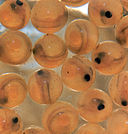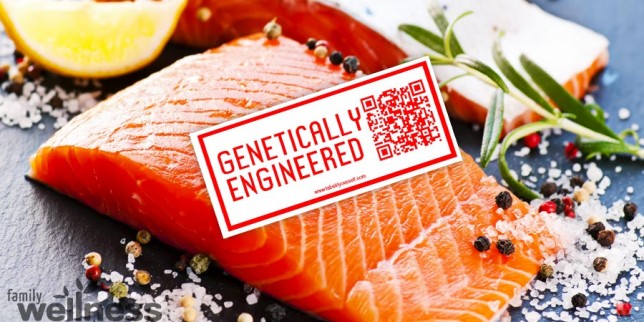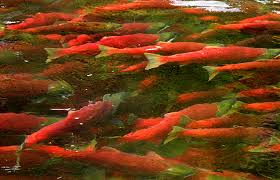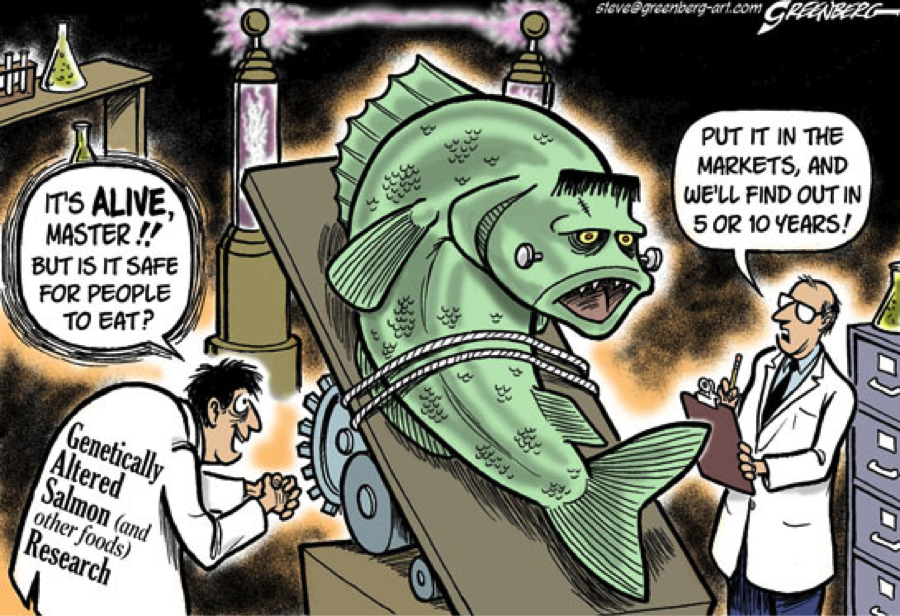GM Salmon Swim to Court
By Joanne Cook, Marine Toxics Co-ordinator, Ecology Action Centre, Halifax, Nova Scotia; and Lucy Sharratt, Coordinator, Canadian Biotechnology Action Network (CBAN).
Nova Scotia’s Ecology Action Centre and British Columbia’s Living Oceans Society are taking the Canadian government to court. Why? To challenge its recent decision to allow AquaBounty Technologies Inc. to manufacture genetically modified (GM) salmon eggs at Bay Fortune, PEI. We contend the federal government violated its own laws in issuing that approval. If AquaBounty’s project goes ahead as planned, PEI will be the birthplace not only of Confederation, but of the first GM food animal in the world.
The approval runs contrary to so many of the causes both organizations have championed over the years – promoting healthy local food, protecting wild salmon, demanding openness and transparency in government decision-making, ensuring thorough risk assessments are part of environmental approvals. The news burst upon us in November of 2013, and we decided we had to take a stand.
This important new legal challenge should give Canadians a rare peek into Canada’s GMO regulation, and the GM salmon will have its day in court.
A Jet-Setting GM Fish

Prince Edward Island is now set to be the world’s first GM fish-egg factory. These genetically engineered Atlantic salmon, trademarked as AquAdvantage® Salmon, have growth hormone genes spliced into them from the Pacific Chinook salmon. In addition, a genetic switch from the ocean pout, an eel-like creature that tolerates very cold water, keeps the growth gene active even in cold weather — unlike natural salmon. The resulting combination makes for year-round growth hormones in the salmon – Frankenfish, if you will - so that it grows much more rapidly than it would naturally.
AquaBounty wants to produce its GM salmon eggs at its facility in PEI, ship the eggs to Panama for grow-out and processing, and send the processed fish into the U.S. consumer market. That’s the company’s initial plan, and it splits the precedent-setting environmental assessment between three countries.
Just before Christmas, 2013, lawyers with Ecojustice (formerly the Sierra Legal Defence Fund) filed a judicial review application on our behalf with the Federal Court, and followed up by serving AquaBounty with a notice of suit in January.
Now that it has the green light from Canada’s Minister of the Environment, the company now has the first of three government approvals that it needs. Word is that the U.S. FDA could approve the GM fish for human consumption any day. Health Canada has not yet approved the GM fish for humans to eat, but if the U.S. government says it’s safe, it’s a good bet that Canada will agree.
It’s true that AquaBounty’s current plan sets out the PEI-Panama-USA route. But -- the Canadian decision actually allows the manufacture of genetically modified salmon eggs, and even the grow-out of the salmon itself, at other facilities in Canada without further assessment, provided the company meets criteria set out in the Minister of the Environment’s November 2013 notice – i.e., keeping the fish indoors. Environment Canada’s approval could be just the start of national and global travels for this GM fish.
An Unlawful Decision
 We argue that the approval of the GM salmon is unlawful because the government, as part of its toxicity assessment, did not assess data regarding whether the GM salmon could become invasive in the environment.
We argue that the approval of the GM salmon is unlawful because the government, as part of its toxicity assessment, did not assess data regarding whether the GM salmon could become invasive in the environment.
GM fish are assessed for environmental risk by the Ministers of the Environment and Health, under the Canadian Environmental Protection Act. Under the Act, those ministers need to assess if the GM salmon is toxic or could become toxic. Without a complete risk assessment, the government is jeopardizing the health and safety of Canada’s environment, especially native fish species like endangered Atlantic salmon.
The legal case asserts that the government’s assessment failed to obtain and assess all the legally-required information, which includes test data on an organism’s potential invasiveness, and that the Ministers made their decisions based on an incomplete toxicity assessment. The groups are asking the court to set aside the decisions and require the Ministers of the Environment and Health to comply with the law before permitting the manufacture of this new genetically modified organism.
“Canadians expect their government to implement, not ignore, the laws that protect our ecosystems from harm,” said Tanya Nayler, one of the Ecojustice lawyers representing the environmental groups. “By granting approval for this genetically modified species without obtaining all the legally required information, the government has once again failed the environment and Canadians.”
Government Secrecy
Canadians only found out that public servants were assessing a request to approve the GM fish on November 23, 2013 -- when the final decision was announced.
Health Canada could also be getting ready to approve the GM salmon for human consumption, but the federal government has kept Canadians in the dark. In an astonishing letter to the Canadian Biotechnology Action Network (CBAN), the Director General of the Food Directorate of Health Canada, Samuel B. Godefroy, said that Health Canada, “is not legally permitted to release information that companies submit and consider confidential…This includes even the mere fact that a submission to the Department has been made.”
Wild Salmon in Danger
 Many Atlantic salmon populations are endangered in Canada and across the world. As EAC’s Marine co-ordinator Susanna Fuller notes, “The Atlantic salmon has evolved over millions of years and is found in cold-water rivers from Maine to Russia. The move to commercial production of GMO Atlantic salmon puts this magnificent wild fish at risk of irreversible genetic contamination”.
Many Atlantic salmon populations are endangered in Canada and across the world. As EAC’s Marine co-ordinator Susanna Fuller notes, “The Atlantic salmon has evolved over millions of years and is found in cold-water rivers from Maine to Russia. The move to commercial production of GMO Atlantic salmon puts this magnificent wild fish at risk of irreversible genetic contamination”.
The company AquaBounty says that the fish won’t escape and if they do, it will not matter because all the GM salmon will be sterile females. However, this is not quite true because the technology to produce sterile fish (induced triploidy) does not work 100% of the time. Even if only 1% of the GM fish remain fertile, escape from confinement could pose a significant environmental threat.
If the GM salmon escape, they may be able to survive and breed in the wild. One Canadian study published last year shows that GM salmon are capable of breeding with brown trout. At a DFO lab in BC some of the world’s top researchers have developed their own fast-growing GM salmon to study environmental questions. The researchers found that their GM salmon were more aggressive in times of scarcity and could outcompete wild salmon for food (Devlin 2004).
Ultimately, the full environmental impacts of GM fish will only be known if an escape happens.
Help us hold our government accountable! Donate today to the legal fund through our crowdfunding campaign through Indiegogo! Want to keep up with the campaign? Follow us on Twitter @GMSalmonTrials. And don’t forget to help us spread the word through all your networks. Tweet about it using #GMFishTrial, Facebook it, reblog on Tumblr – every bit helps.
SIDEBOARD: About AquaBounty Technologies, Inc.
AquaBounty is incorporated in the State of Delaware, USA; it is listed on the London, UK Stock Exchange, but its securities are not currently publicly traded in the US markets, nor are they registered with the US Securities and Exchange Commission. Members of the current board of AquaBounty have backgrounds in major corporations including Monsanto, American Cyanamid, Merck, White Rock Capital Management, Aetna, and KPMG. For some time, the Georgian investor Kakha Bendukidze owned almost 48% of the company's stock, before selling to American synthetic biology firm Intrexon – whose website is www.dna.com - in October 2012. The corporation has struggled financially, but its stock price rebounded after Environment Canada issued its approval in November, 2013.
ACOA, Enterprise PEI, the Technology Partnership Canada (TPC) and the National Research Council have all supported AquaBounty with public money in loans and grants over the years. As well as AquAdvantage® Salmon, AquaBounty is working on similarly engineered trout and tilapia.

Cartoon by Steve Greenberg, www.greenberg-art.com, used here with artist's
permission: http://greenberg-art.com/.Toons/environment.html

- Log in to post comments

